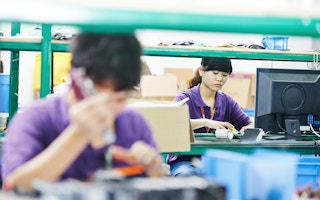Manufacturers today are at a crossroads. One way is the business-as-usual approach based on the linear economy, in which goods are made to be used for a short time by consumers and then mostly dumped or incinerated. But with a growing world population and the emergence of billions of new consumers in the rising markets, most people realize this is not sustainable.
In addition, the linear system contributes to climate change and damages other ecosystems such as rivers. It also lacks a focus on excluding toxicity in products. A better system needs to be created and one avenue which is gaining ground is the circular economy, in which goods are designed to be remade in an ongoing non-toxic closed-loop system.
Asia is well aware of the need to change, not least because much of the world’s waste ends up in its backyard as well as in other emerging markets. As one writer put it recently in The Guardian newspaper:
“The developing world is becoming the West’s digital dumping ground. Every year around 50 million tonnes of unwanted electronic devices make their way to vast e-waste dumps in Guiyu in China and Agbogbloshie in Ghana – often illegally. Some of them will be repaired and resold. Others will be broken into their components, at considerable expense to the environment and people’s health, and sold as raw materials to manufacturers. Yet more will be left as piles of toxic litter.”
If this continues the problem will only get worse. The article continues: “In fact, only around 13% of the e-waste generated each year is recycled. The increasing amounts of digital tech brought by middle-class consumers in China, India and Africa is a growing part of the problem. If the trend continues, the annual amount of global e-waste will be 65 million tonnes by 2017.”
It is not just about designing products so that they can be returned, disassembled and recycled. It is about thinking about how to make a product good from the start, so that it has a positive impact on the environment and human health.
Cradle-to-cradle pioneers Dr Michael Braungart and William McDonough have inspired many businesses with their call for designing for “eco-effectiveness”, as described in their latest book, The Upcycle: “Human beings don’t have a pollution problem; they have a design problem. If humans were to devise products, tools, furniture, homes, factories and cities more intelligently from the start, they wouldn’t even need to think in terms of waste, or contamination, or scarcity. Good design would allow for abundance, endless reuse, and pleasure.”
That is the vision. But can this be adopted by manufacturers at scale? There are important pioneers in this area showing the way. For example, electronics company Philips does not sell light, it leases it. This service-based model encourages manufacturers to make durable products that can be disassembled later and recycled, reused or remanufactured in a healthy and responsible way. And Philips is showing the model can be profitable and popular with customers.
“
China has the economies of scale and diversity in production processes to make remanufacturing and materials reuse economically viable, particularly for small and medium sized manufacturers.
Mobile phones are another industry ripe for circular innovation. Towards the Circular Economy (Volume One), a report from the Ellen MacArthur Foundation and McKinsey, looked into the economic benefits of making smart phone production circular. The report notes how much material goes to waste at the moment (mobiles contain valuable metals such as silver, gold and various rare earth metals).
“In Europe alone, for example, 160 million discarded but uncollected [mobile] devices represent a material loss of up to $500 million annually. With collection rates in Europe hovering around 15% and mobile phone designs becoming increasingly integrated, there is hardly any component reuse or remanufacturing, and the secondary mobile phone market (while fast growing) is almost negligible at around 6% of the primary market.”
And there is a business case for going this way, the report concluded:
“The resulting economic impact of an enlarged market for refurbished smartphones could be considerable. In a transition scenario in which collection rates are increased to 50%, and in which 60% of collected devices are ultimately refurbished, overall material input cost savings in the European B2B smartphone market could amount to more than EUR 350 million per year. Such a system would also save an estimated 100 thousand tonnes of CO2e emissions (measured in the linear supply chain) and would reduce manufacturing energy costs by $4 million.”
Bibi Bleekemolen, research and outreach officer for Fairphone, a young company breaking into this market noted that manufacturers always have “the responsibility to make sure that the consumer knows what to do with it afterwards, and that you can make use of it yourself again”.
Can China, the world’s economic powerhouse, lead the way in circularity? A recent report from the Fung Institute and the Ellen MacArthur Foundation concluded that it might: “There is potential for China to lead the adoption of circular economies in Asia, and possibly globally. China has the economies of scale and diversity in production processes to make remanufacturing and materials reuse economically viable, particularly for small and medium sized manufacturers.”
Goodbaby, for example, a Chinese manufacturer of strollers, high chairs, cribs and children’s car seats based near Shanghai, has been developing cradle-to-cradle products since 2010. Advised by the European consultancy EPEA, founded by Braungart, Goodbaby has a blueprint to get all its products C2C certified by 2020.
If we can encourage industry worldwide to follow this path and scale up, the future of manufacturing could help to transform the modern economy into a truly sustainable one.
Alexander Collot d’Escury is Chief Executive Officer of Desso. This post originally appeared on the World Economic Forum blog.











